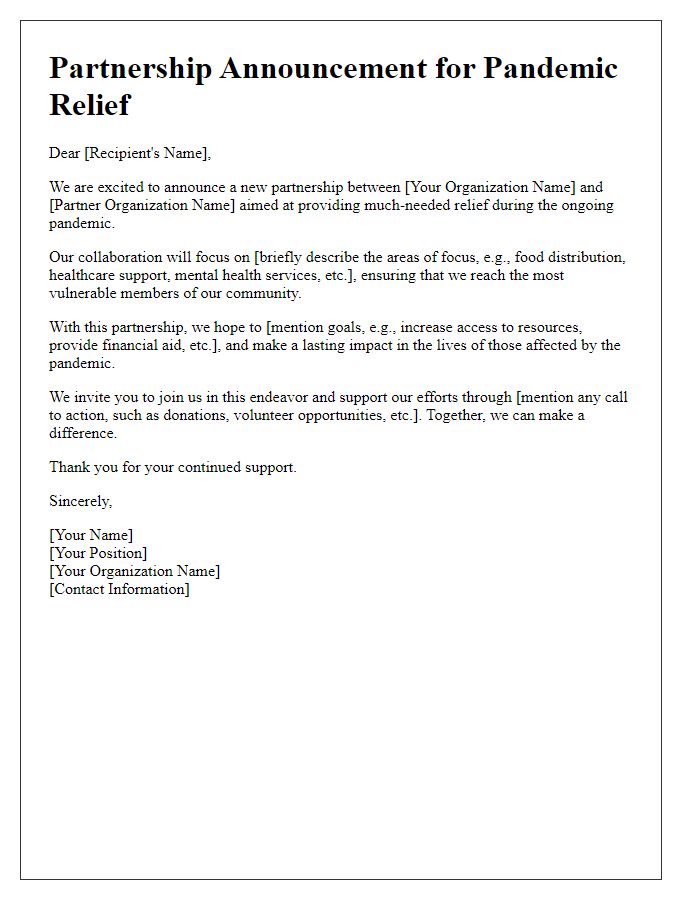In the wake of the recent pandemic, crafting a well-structured letter is crucial for conveying important response measures to your audience. Whether you're reaching out to employees, customers, or community members, using a clear template will help ensure that your message is both informative and reassuring. This guide will provide you with essential tips to create a letter that not only addresses safety protocols but also fosters a sense of unity and support. Ready to learn how to create an impactful letter that can make a difference? Let's dive in!

Clear communication guidelines
Effective communication guidelines during pandemics, especially COVID-19, are crucial for informing communities about health protocols. Public health authorities, such as the Centers for Disease Control and Prevention (CDC), recommend regularly updating information on transmission risks, vaccination availability, and safety measures. Utilize multiple channels, including social media platforms like Twitter and Facebook, as well as traditional media outlets like newspapers and local radio stations, to reach diverse audiences. Additionally, employing clear messaging strategies, such as FAQs and infographics, can help convey complex information. Crisis communication should address community concerns promptly, focusing on specific demographics, such as the elderly population and healthcare workers, to ensure tailored support during health emergencies.
Safety and health protocols
Safety protocols during pandemics, particularly COVID-19, involve essential measures to protect public health. Frequent handwashing (at least 20 seconds with soap), use of hand sanitizers (containing at least 60% alcohol), and wearing masks (especially in crowded spaces) serve as critical components. Social distancing guidelines suggest maintaining a distance of at least six feet (approximately 1.8 meters) from others to minimize virus transmission risk. Regularly disinfecting high-touch surfaces, such as doorknobs and phones, contributes to reducing contamination chances. Additionally, following government health authorities' mandates (for instance, the CDC in the United States or the WHO globally) ensures compliance with established safety standards. Vaccination campaigns aim to immunize populations, decreasing the spread and severity of infections, promoting herd immunity.
Remote work and virtual engagement options
The pandemic has necessitated significant changes in workplace dynamics, particularly in terms of remote work and virtual engagement solutions. Organizations have adopted platforms like Zoom and Microsoft Teams to facilitate seamless communication among employees, ensuring productivity even when working from various locations. A staggering rise in telecommuting has been noted, with reports indicating that over 70% of the workforce transitioned to remote operations during the peak of the COVID-19 pandemic. Companies have implemented specific guidelines for virtual meetings, encouraging regular check-ins and fostering team collaboration through digital tools. Moreover, online resources such as training webinars and virtual team-building exercises have been introduced to maintain morale and strengthen connections among staff members across geographical boundaries. Continuous evaluations of these measures are essential to enhance engagement and support employee mental health throughout the ongoing crisis.
Support resources and contact information
During the COVID-19 pandemic, numerous support resources have been made available to assist individuals and families. Government programs like the Economic Impact Payment (stimulus checks) provide financial assistance, reaching millions of Americans through the Internal Revenue Service (IRS). Local health departments offer free testing and vaccination services, with community vaccination clinics set up in numerous regions including urban centers like New York City and Los Angeles. Mental health helplines, such as the National Suicide Prevention Lifeline (1-800-273-TALK), provide essential counseling services. Additionally, food assistance programs like SNAP (Supplemental Nutrition Assistance Program) continue to serve those in need. For further assistance, individuals can contact their state's emergency management office or visit official websites for updated resources and guidance tailored to specific communities and needs during these unprecedented times.
Policy updates and compliance requirements
The pandemic response measures instituted during the COVID-19 crisis have resulted in numerous policy updates for businesses and organizations worldwide. New compliance requirements specify social distancing protocols, mandatory mask-wearing, and regular sanitization practices to mitigate the spread of the virus, particularly in high-density locations such as warehouses and office buildings. Local health authorities, mandated by the Centers for Disease Control and Prevention (CDC) guidelines, emphasize the importance of employee health screenings, including temperature checks and symptom surveys, to ensure workplace safety. These measures remain crucial as community transmission rates continue to fluctuate across different states and regions in the United States, necessitating ongoing training for staff to adapt to evolving regulations and best practices.
Letter Template For Pandemic Response Measures Samples
Letter template of event cancellations or modifications due to pandemic.













Comments